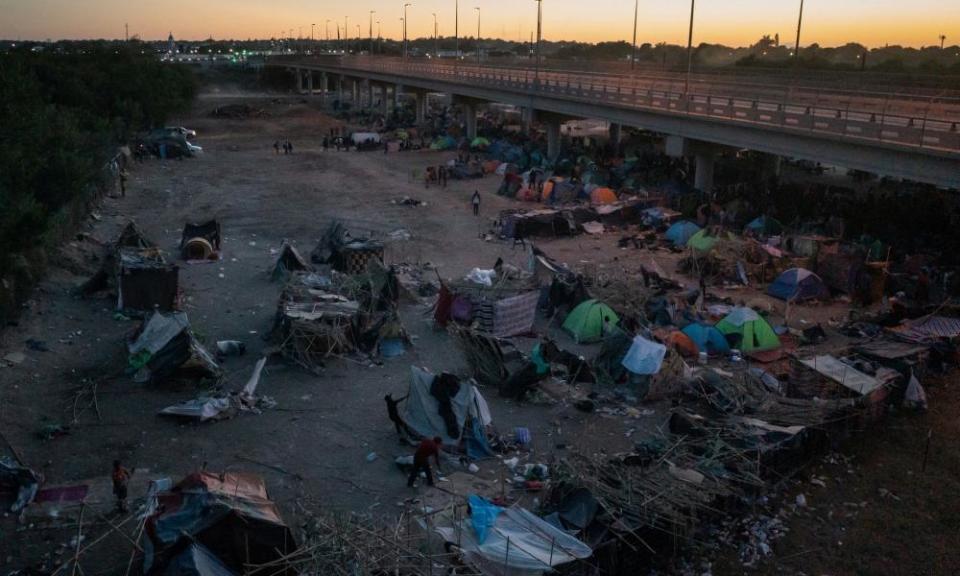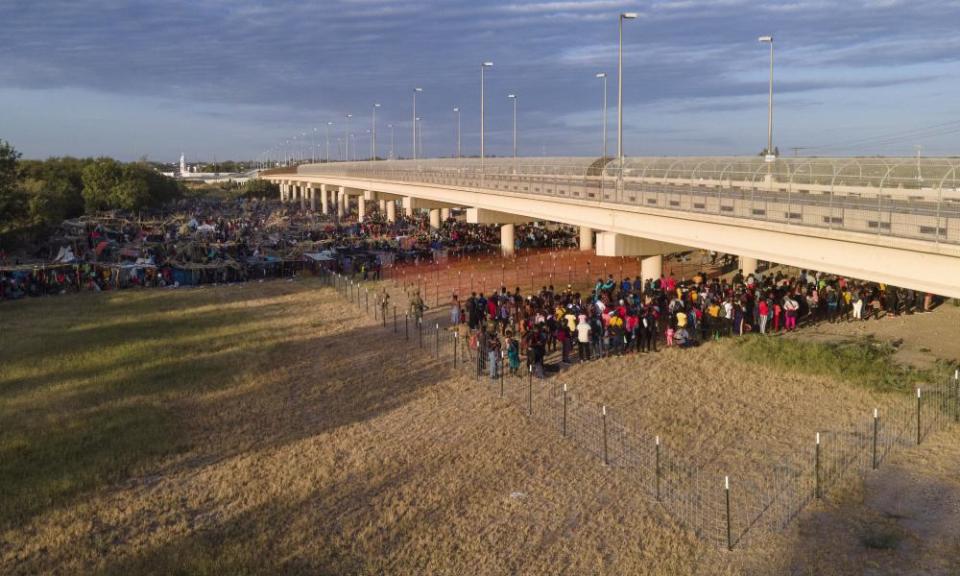‘Luck is not on our side’: Del Rio resembles dusty war zone as 5,000 migrants remain

“Welcome to Texas,” says a big, green sign near the Del Rio International Bridge.
Related: Haitians reportedly being released in US likely include pregnant women and families
But no one is welcome here, not since the west Texas border city has transformed into what could be mistaken for a war zone. What looks like a helicopter – barely discernible in the afternoon sky – looms nearby. The earth, beige and dusty, is crawling with security personnel carrying assault weapons.
The small border city of Del Rio, population about 35,000, this week became a symbolic ground zero for Haitians escaping to the United States, as political and environmental strife force a mass exodus from the Caribbean nation. Thousands of migrants and asylum seekers have set up camp under Del Rio’s International Bridge, waiting to be processed by immigration officials.
Shocking images from the jam-packed encampment have suggested chaos and terror in recent days: Black migrants wading through the Rio Grande River, confronted by aggressive border patrol agents on horseback. The Biden administration halted border patrol agents’ use of horses in Del Rio on Thursday, amid public outcry over disturbing pictures showing them charging at migrants.

Yet anyone still under the squalid bridge has now been rendered invisible to the outside world, locked down behind gates, fences and armed guards.
Just minutes away, though, vans pull up to a nondescript building, and people pour out. They’ve arrived at yet another waystation on their transnational journey, this time greeted by volunteers who give them pizza slices and water bottles before the next leg.
On Thursday afternoon, vans came one after the other in a near-constant succession. An aid worker, Santiago Pardo, says mornings are even busier. The migrants and asylum seekers show up whenever border patrol decides it’s time.
“There’s literally no schedule,” Pardo says. “They just inform us, you know, ‘Hey, we’re on our way.’”
The outdoor space is teeming with babies and young children, many of them too tiny to walk. One infant holds tight to a stuffed lion toy. Another little boy is wearing too-long shorts, patterned with the American flag.
Most are coming from Haiti, Cuba or Venezuela, Pardo says. Aid workers speaking earlier this week estimated that about 70-80% of people were originally from Haiti.
At its height, the Del Rio encampment at the US-Mexico border harbored about 14,000 migrants earlier this week. Now, under 5,000 remain in the Del Rio sector as a whole, according to the White House. But even as traffic at the camp is dwindling, the situation has deteriorated, Pardo says – though he doesn’t know enough to provide details.

As Pardo attends to new arrivals at the aid stop, Ignace Zidor checks every van that comes through for his 27-year-old sister. When he last heard from her on 17 September, she was under the bridge with her husband and two young children.
“They said they were living in the dust. Sleeping in the dust. And it was terrible,” he says.
Ignace – who is originally from Haiti but moved to the US in 2006 – arrived in Del Rio around noon on Thursday, after he and his wife Vista drove 10 hours from Oklahoma. He’s desperate to find his little sister, who doesn’t know his home address and might have lost his phone number.
She could be in Houston, or Mexico, or still under the bridge. But he’s hoping to catch her here.
“So far, luck is not on our side,” he admits.
Vista starts crying as she watches others in line for a bus. “These people came all the way through danger, turmoil, with a baby on their hip, and they’ve made it,” she says. “They made it here.”
But not everyone’s so lucky. Amid the humanitarian crisis in Del Rio, more than 1,400 Haitians have been repatriated since Sunday, without the due process afforded to other migrants. Haitians have long been put into the blanket category of “economic refugees” by the US, allowing authorities to ignore or quickly deny claims for asylum. Who gets released into the US from Del Rio and who is forcibly expelled largely remains a riddle.

The hardline policy is also relic of the Trump era’s pandemic response that effectively shuttered the border to most asylum seekers, without the ability to first seek asylum. Joe Biden has continued to apply it, albeit through piecemeal and often unclear enforcement decisions.
This is not the first humanitarian migration crisis the Biden administration has encountered in almost eight months in office, and it will not be the last. The number of migrants arriving at the south-western border in June was the highest in years, according to data from Customs and Border Protection.
Having promised a more human system on the campaign trail, Biden is under increasing pressure from Democrats and Republicans to spell out what immigration reforms he intends to implement.
Meanwhile, Daniel Foote, the new US envoy to Haiti, resigned in protest against the “inhumane” mass expulsions earlier this week. And Democratic firebrand representative Maxine Waters excoriated the Biden administration for continuing Trump’s immigration legacy.
“What the hell are we doing here?” Waters said, alluding to the now viral images of border patrol menacing Black migrants with horse reins. “What we witnessed takes us back hundreds of years. What we witnessed was worse than what we witnessed in slavery.”
Haitians who are being forcibly repatriated will return to a nation in ruins, after President Jovenel Moïse was assassinated and a devastating earthquake hit earlier this year.
Vista pulls up a photo of her 65-year-old mother-in-law’s home, reduced to remnants after the natural disaster. She’s now surviving under a tarp with two of her sons, homeless.
Haiti is no place to live right now, Ignace says, and everyone who makes it to the US should have the opportunity to apply for asylum.
“Sending them back to Haiti’s just killing them twice.”

 Yahoo Finance
Yahoo Finance 